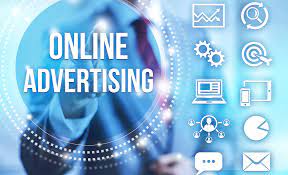
Unlocking Success: The Evolution of Digital Media Advertising Strategies
The Power of Digital Media Advertising
In today’s fast-paced digital age, the landscape of advertising has undergone a significant transformation. Digital media advertising has emerged as a powerful tool for businesses to reach their target audience in a more direct and engaging manner.
Unlike traditional forms of advertising, such as print or TV ads, digital media advertising offers unparalleled opportunities for targeting specific demographics, interests, and behaviours. Through platforms like social media, search engines, and websites, businesses can tailor their messages to resonate with individual consumers.
One of the key advantages of digital media advertising is its measurability. With advanced analytics tools, businesses can track the performance of their ad campaigns in real-time, allowing them to make data-driven decisions and optimise their strategies for better results.
Furthermore, digital media advertising enables businesses to engage with their audience in interactive ways. From clickable ads to immersive video campaigns, brands can create compelling content that not only captures attention but also encourages action.
Another benefit of digital media advertising is its cost-effectiveness. Compared to traditional forms of advertising, digital ads often have lower entry barriers and can be tailored to suit various budgets. This flexibility allows businesses of all sizes to leverage the power of online marketing.
As technology continues to evolve, so does the landscape of digital media advertising. From AI-powered targeting algorithms to virtual reality experiences, the possibilities are endless for brands looking to make an impact in the digital realm.
In conclusion, digital media advertising has revolutionised the way businesses connect with consumers. By harnessing the power of data-driven strategies and engaging content formats, businesses can unlock new opportunities for growth and success in the ever-evolving digital landscape.
Understanding Digital Media Advertising: Common Questions and Answers
- How do you advertise digital media?
- How is advertising done on digital media?
- What are the 3 types of digital media?
- What are the 3 main types of digital ads?
- What is digital media advertising?
- What are the four types of digital advertising?
- What is the best digital media advertising?
- What is digital digital advertising?
- What is an example of digital marketing media?
How do you advertise digital media?
To effectively advertise digital media, businesses can employ a variety of strategies tailored to their specific goals and target audience. Utilising social media platforms, search engine marketing, display advertising, influencer partnerships, and content marketing are common tactics. By understanding the preferences and behaviours of their target audience, businesses can create engaging and relevant content that resonates with users. Additionally, leveraging data analytics to track campaign performance and make informed adjustments is crucial for maximising the impact of digital media advertising efforts.
How is advertising done on digital media?
Advertising on digital media is a multifaceted process that involves leveraging various online platforms to promote products or services. Businesses utilise a range of strategies, including social media ads, search engine marketing, display advertising, and influencer partnerships, to reach their target audience effectively. By crafting compelling ad creatives, targeting specific demographics, and monitoring campaign performance through data analytics, businesses can refine their digital advertising efforts for optimal results. The dynamic nature of digital media allows for real-time adjustments and continuous optimisation to ensure that ads resonate with consumers and drive desired actions.
What are the 3 types of digital media?
In the realm of digital media advertising, there are three primary types of digital media that businesses commonly leverage to reach their target audiences: owned media, earned media, and paid media. Owned media refers to content assets that a brand owns and controls, such as its website, social media profiles, and email newsletters. Earned media encompasses publicity and exposure gained through word-of-mouth, social sharing, reviews, and mentions by third parties. Paid media involves paid advertising placements on various digital platforms like search engines, social media networks, and websites to amplify brand visibility and reach specific audience segments. Understanding how to strategically utilise these three types of digital media is essential for creating a comprehensive and effective advertising strategy in today’s competitive online landscape.
What are the 3 main types of digital ads?
In the realm of digital media advertising, understanding the three main types of digital ads is crucial for crafting effective marketing campaigns. The first type is display ads, which encompass visual advertisements that appear on websites and apps in various formats such as banners, images, or rich media. Secondly, search ads are text-based advertisements that appear on search engine results pages based on specific keywords, targeting users actively searching for related products or services. Lastly, video ads are engaging multimedia content displayed on platforms like YouTube or social media to captivate audiences through storytelling and visual appeal. By utilising these diverse ad formats strategically, businesses can maximise their reach and engagement with their target audience in the digital landscape.
What is digital media advertising?
Digital media advertising refers to the strategic promotion of products or services through various online channels such as social media platforms, search engines, websites, and mobile applications. It involves creating targeted and engaging content to reach specific audiences based on demographics, interests, and behaviours. Digital media advertising leverages the power of technology and data analytics to deliver personalised messages that resonate with consumers in a more direct and interactive manner. This form of advertising allows businesses to track performance metrics in real-time, optimise campaigns for better results, and ultimately drive engagement and conversions with their target audience in the digital space.
What are the four types of digital advertising?
In the realm of digital media advertising, there are four primary types of digital advertising that businesses commonly utilise to reach their target audiences effectively. These include display advertising, which involves visually engaging banners or ads on websites; search advertising, where businesses bid on keywords to appear in search engine results; social media advertising, which leverages platforms like Facebook and Instagram for targeted campaigns; and video advertising, which utilises videos to convey messages and capture audience attention. Each type offers unique advantages and can be strategically employed to enhance brand visibility and engagement in the competitive online landscape.
What is the best digital media advertising?
When it comes to determining the best digital media advertising strategy, there is no one-size-fits-all answer. The effectiveness of a digital media advertising approach depends on various factors, including the target audience, campaign objectives, budget, and industry trends. Some businesses may find success with social media advertising due to its ability to engage users, while others may benefit more from search engine marketing for capturing intent-driven leads. Ultimately, the best digital media advertising strategy is one that aligns closely with the specific goals and needs of the business, leveraging a mix of channels and tactics to maximise reach and ROI in today’s competitive online landscape.
What is digital digital advertising?
Digital advertising refers to the practice of promoting products, services, or brands through online channels such as websites, social media platforms, search engines, and mobile apps. It encompasses a wide range of formats, including display ads, video ads, social media ads, search engine marketing (SEM), and more. Digital advertising allows businesses to reach their target audience in a highly targeted and measurable way, leveraging data and analytics to optimise campaigns for better results. By utilising the diverse capabilities of digital platforms, businesses can engage with consumers in interactive ways and drive desired actions effectively.
What is an example of digital marketing media?
An example of digital marketing media is social media platforms like Facebook, Instagram, Twitter, and LinkedIn. These platforms serve as powerful channels for businesses to promote their products or services, engage with their target audience, and drive conversions. Through targeted advertising campaigns, businesses can reach specific demographics based on interests, behaviours, and other criteria, making social media an effective tool for increasing brand awareness and generating leads. Additionally, the interactive nature of social media allows brands to foster relationships with customers through engaging content such as posts, videos, and live streams.

